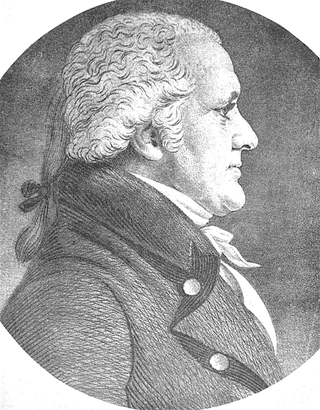
The Lewis and Clark Expedition, also known as the Corps of Discovery Expedition, was the United States expedition to cross the newly acquired western portion of the country after the Louisiana Purchase. The Corps of Discovery was a select group of U.S. Army and civilian volunteers under the command of Captain Meriwether Lewis and his close friend Second Lieutenant William Clark. Clark, along with 30 others, set out from Camp Dubois, Illinois, on May 14, 1804, met Lewis and ten other members of the group in St. Charles, Missouri, then went up the Missouri River. The expedition crossed the Continental Divide of the Americas near the Lemhi Pass, eventually coming to the Columbia River, and the Pacific Ocean in 1805. The return voyage began on March 23, 1806, at Fort Clatsop, Oregon, ending six months later on September 23 of that year.

The 9th United States Congress was a meeting of the legislative branch of the United States federal government, consisting of the United States Senate and the United States House of Representatives. It met in Washington, D.C., from March 4, 1805, to March 4, 1807, during the fifth and sixth years of Thomas Jefferson's presidency. The apportionment of seats in the House of Representatives was based on the 1800 United States census. Both chambers had a Democratic-Republican majority.

Charles Willson Peale was an American painter, soldier, scientist, inventor, politician, and naturalist.

The Corps of Discovery was a specially established unit of the United States Army which formed the nucleus of the Lewis and Clark Expedition that took place between May 1804 and September 1806. The Corps was led jointly by Captain Meriwether Lewis and Second Lieutenant William Clark. Commissioned by President Thomas Jefferson, the Corps' objectives were scientific and commercial – to study the area's plants, animal life, and geography, and to learn how the Louisiana Purchase could be exploited economically. Aside from its military composition, the Corps' additional personnel included scouts, boatmen, and civilians.

The Territory of Orleans or Orleans Territory was an organized incorporated territory of the United States that existed from October 1, 1804, until April 30, 1812, when it was admitted to the Union as the State of Louisiana.

Theophilus Cazenove, or Theophile Cazenove, was a Dutch financier and one of the agents of the Holland Land Company.

John Vanderlyn was an American neoclassicist painter.

Edmund Pendleton Gaines was a career United States Army officer who served for nearly fifty years, and attained the rank of major general by brevet. He was one of the Army's senior commanders during its formative years in the early to mid-1800s, and was a veteran of the War of 1812, Seminole Wars, Black Hawk War, and Mexican–American War.

Michael Leib was an American physician and politician from Philadelphia. He served as a surgeon in the Philadelphia Militia during the American Revolutionary War. He served as a Democratic-Republican member of the Pennsylvania House of Representatives three times; from 1795 to 1798, 1806 to 1808 and 1817 to 1818. He served as a member of the United States House of Representatives for Pennsylvania's 2nd congressional district from 1799 to 1803 and for Pennsylvania's 1st congressional district from 1803 to 1806. He served as a member of the United States Senate for Pennsylvania from 1809 to 1814. He also served as a member of the Pennsylvania State Senate for the 1st district from 1818 to 1821.
Events from the year 1770 in art.

Theodosia Burr Alston was an American socialite and the daughter of the third U.S. Vice President, Aaron Burr, and Theodosia Bartow Prevost. She became First Lady of South Carolina after her husband, Joseph Alston, became governor of South Carolina during the War of 1812. She was lost at sea at age 29.

Elisabeth Henriette Marthe Lorimier was a popular portraitist in Paris at the beginning of Romanticism.

Perez Morton was an American lawyer, politician and revolutionary patriot in Boston, Massachusetts. He was Massachusetts Attorney General from 1810 until 1832.

A physiognotrace is an instrument, designed to trace a person's physiognomy to make semi-automated portrait aquatints. Invented in France in 1783–1784, it was popular for some decades. The sitter climbed into a wooden frame, sat and turned to the side to pose. A pantograph connected to a pencil produced within a few minutes a "grand trait", a contour line on a piece of paper. With the help of a second scaling-down pantograph, the basic features of the portrait were transferred from the sheet in the form of dotted lines to a copper plate, which had previously been prepared with a ground for etching. One week later, the sitter received an etched plate and twelve little prints. The device but also the aquatint prints are called physionotraces.
Events from the year 1804 in the United States.

Events from the year 1805 in the United States.
Events from the year 1806 in the United States.

Events from the year 1807 in the United States.

Anne Marguérite, Baroness Hyde de Neuville was a French aristocrat and self-taught watercolorist and artist. She is best known for her drawings of people and landscapes she encountered in her travels in America during the first decades of the 19th century. She left behind a sizable body of work of over 200 watercolors and drawings.

John Edwards Caldwell was an American author, philanthropist, and politician who co-founded the American Bible Society and the Christian Herald.





































